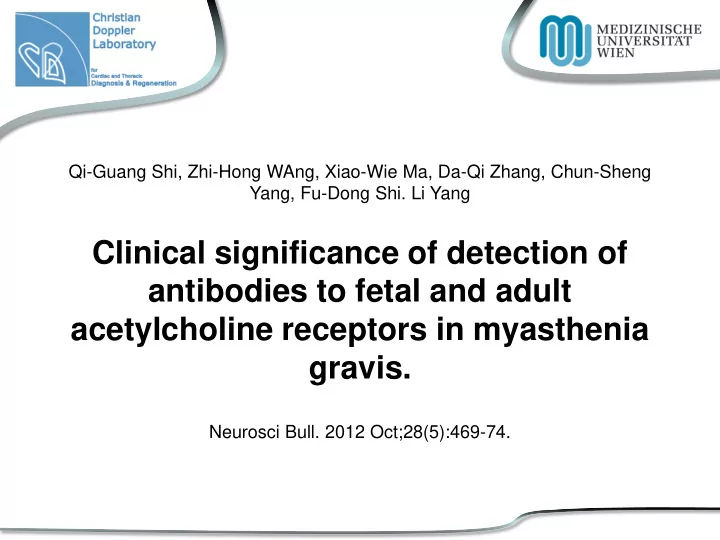

Qi-Guang Shi, Zhi-Hong WAng, Xiao-Wie Ma, Da-Qi Zhang, Chun-Sheng Yang, Fu-Dong Shi. Li Yang Clinical significance of detection of antibodies to fetal and adult acetylcholine receptors in myasthenia gravis. Neurosci Bull. 2012 Oct;28(5):469-74.
Myasthenia gravis • autoimmune disorder • T-cells and B-cells • endplate region of the NMJ • autoantibodies against AchR and other muscle antigens • functional loss of AchR • muscle weakness and excessive fatigue
Classification • Ocular Myasthenia gravis (OMG): ptosis and/or double vision • Generalized Myasthenia Gravis (GMG)
Ach-Receptor • Fetal: 2 α , β , γ , δ • Adult: 2 α , β , ε , δ Conventional diagonstic radioimmunoassays use fetal AchR as antigen.
Material and methods • Cell based assay: – fetal-type and adult-type AchRs as antigens • Patiens: – 90 OMG and 110 GMG • Controls: – 25 healthy blood donors – 25 patients with other neurological diseases (multiple slerosis, neuromyelitis optica, clinically isolated syndrome, Guillain-Barre syndrome, cerebrovascular infarction and encephalitis)
Diagnosis of MG • Fluctuating and fatigable weakness of volontary muscles together with at least one of the following criteria: – Positive serum anti-AchR antibody – Repetitive nerve stimulation at 3 Hz showing >15% decrement of compound muscle action potentials – Abnormal single-fiber EMG with jitter or block – Unequivocal positive response to intramuscular neostigmine
Classification according to the clinical distribution of muscle involvement: • Group I: OMG, weakness exclusive to eyelids, did not progress to GMG within the first 2 years • Group II: patients with GMG – Group IIa: generalized weakness at disease onset – Group IIb: only ocular involvement during the first months, but transformation to GMG later
Cell-based assay (CBA) 1. cDNA encoding the human AchR subunits were cloned Control plasmid: human rapsyn cDNA 2. Human embryonic kidney 293 cells transfected with fetal or adult AchR subunits (EGFP-tagged rapsyn for AchR aggregation) 3. After 48h, incubation of cells with patient sera diluted with DMEM 4. After washing, cells were fixed with formaldehyde 5. Incubation of cells with Alexa fluor 568-conjugated goat anti-human IgG 6. Examination on an inverted fluorescence microscope
• Binding of AchR was scored semiquantitively on a scale of 0 to 4 • On basis of control results, samples scored 1 or more were classified as positive
Results
• Anti-adult antibodies in 70% • Anti-fetal antibodies in 66% • Sensitivity increased by 11% when using adult and fetal types combined (P=0.015) • Positive ratio of anti-fetal and/or anti-adult antibodies was – 71% in group I – 73% in group IIa – 91% in group IIb • Antibodies to adult and fetal AchR was higher in group IIb (82%) than in group I (42%) (P<0.001) • Risk for development of GMG increased in older patients (OR 1.03) and in patients with antibodies to both adult and fetal AchR (OR 5.09)
Discussion • α - Subunit is thought to be immunodominant, bearing the main immunogenic regions. This study revealed the distributions of autoantibodies to the AchR ε or γ . • A previous study reported that anti-fetal AchR-specific antibodies alone are insufficient to cause ocular muscle weakness. In this study two patients with GMG had antibodies that bound only to the AchR γ subunit. • For conventional diagnostics fetal AchR ist used as the antigen. This method fails to detect antibodies that only bind to the anti-AchR ε subunit.
Discussion • Except for the levator palpebrae muscles, extraocular muscles express both adult and fetal isoforms of the AchR. The risk for developing GMG increased in patients with antibodies for both fetal and adult AchR. • Mean age at disease onset for group IIb was significantly higher than for group I.
Recommend
More recommend